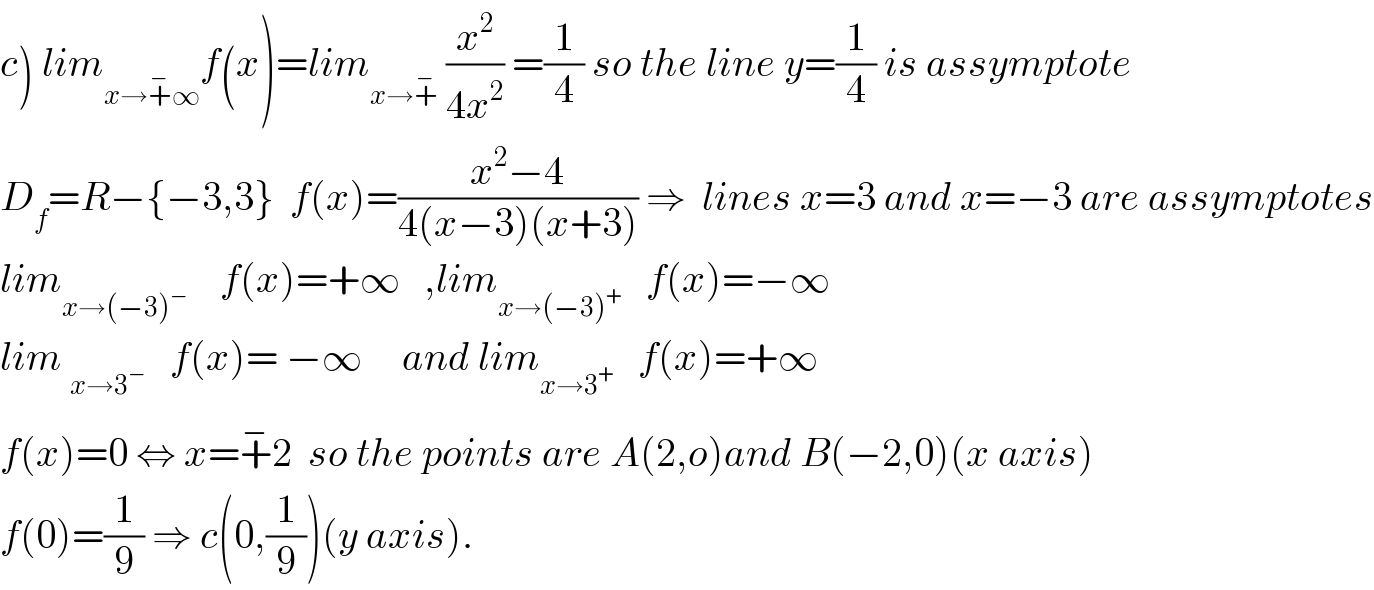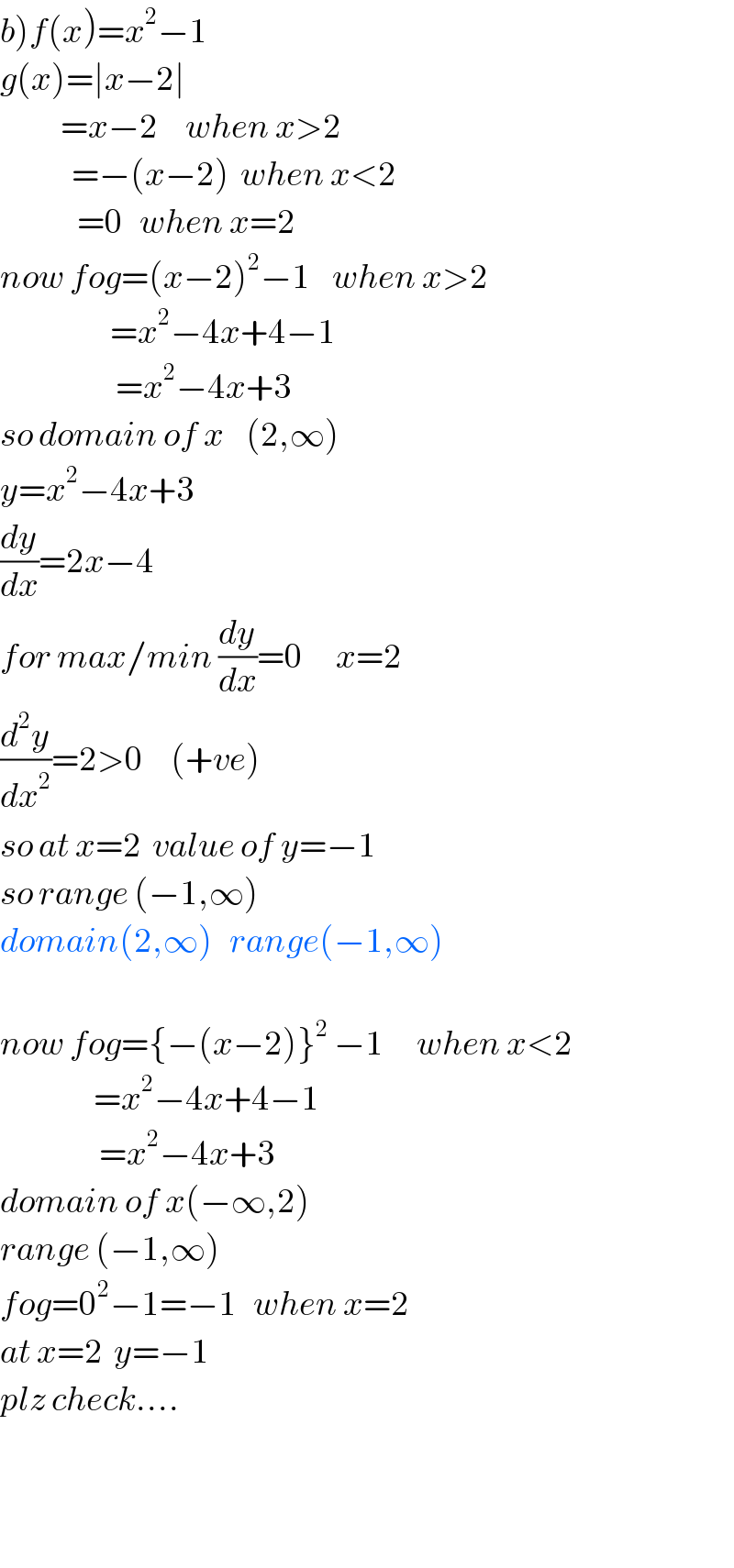
Question Number 44194 by peter frank last updated on 23/Sep/18

Commented by maxmathsup by imad last updated on 23/Sep/18
![ii) fog(x)=f(g(x))=∣x−2∣^2 −1=(x−2)^2 −1=x^2 −4x+4−1=x^2 −4x+3 this function is defined on R we have (fog)^′ (x)=2x−4 =2(x−2) so we get the variation x −∞ 2 +∞ (fog)^′ − + fog(x) +∞ dec−1 incr +∞ so fog([2,+∞[ =[−1,+∞[ and fog(]−∞ ,2]) =]−1,+∞[](Q44205.png)
$$\left.{ii}\right)\:{fog}\left({x}\right)={f}\left({g}\left({x}\right)\right)=\mid{x}−\mathrm{2}\mid^{\mathrm{2}} −\mathrm{1}=\left({x}−\mathrm{2}\right)^{\mathrm{2}} −\mathrm{1}={x}^{\mathrm{2}} \:−\mathrm{4}{x}+\mathrm{4}−\mathrm{1}={x}^{\mathrm{2}} −\mathrm{4}{x}+\mathrm{3} \\ $$$${this}\:{function}\:{is}\:{defined}\:{on}\:{R}\:{we}\:{have} \\ $$$$\left({fog}\right)^{'} \left({x}\right)=\mathrm{2}{x}−\mathrm{4}\:=\mathrm{2}\left({x}−\mathrm{2}\right)\:\:{so}\:{we}\:{get}\:{the}\:{variation} \\ $$$${x}\:\:\:\:\:\:\:\:−\infty\:\:\:\:\:\:\:\:\:\:\:\:\:\mathrm{2}\:\:\:\:\:\:\:\:\:\:\:\:\:\:\:\:+\infty \\ $$$$\left({fog}\right)^{'} \:\:\:\:\:\:\:\:\:\:\:−\:\:\:\:\:\:\:\:\:\:\:\:\:\:\:\:+ \\ $$$${fog}\left({x}\right)\:+\infty\:{dec}−\mathrm{1}\:\:\:\:{incr}\:\:+\infty\:\:\:{so}\:\:{fog}\left(\left[\mathrm{2},+\infty\left[\:=\left[−\mathrm{1},+\infty\left[\:{and}\right.\right.\right.\right.\right. \\ $$$$\left.{f}\left.{o}\left.{g}\left(\right]−\infty\:,\mathrm{2}\right]\right)\:=\right]−\mathrm{1},+\infty\left[\right. \\ $$
Commented by maxmathsup by imad last updated on 23/Sep/18
![fog(x)=(]−∞,2])=[−1,+∞[](Q44206.png)
$$\left.{f}\left.{og}\left({x}\right)=\left(\right]−\infty,\mathrm{2}\right]\right)=\left[−\mathrm{1},+\infty\left[\right.\right. \\ $$
Commented by maxmathsup by imad last updated on 23/Sep/18

$$\left.{c}\right)\:{lim}_{{x}\rightarrow\overset{−} {+}\infty} {f}\left({x}\right)={lim}_{{x}\rightarrow\overset{−} {+}} \:\frac{{x}^{\mathrm{2}} }{\mathrm{4}{x}^{\mathrm{2}} }\:=\frac{\mathrm{1}}{\mathrm{4}}\:{so}\:{the}\:{line}\:{y}=\frac{\mathrm{1}}{\mathrm{4}}\:{is}\:{assymptote} \\ $$$${D}_{{f}} ={R}−\left\{−\mathrm{3},\mathrm{3}\right\}\:\:{f}\left({x}\right)=\frac{{x}^{\mathrm{2}} −\mathrm{4}}{\mathrm{4}\left({x}−\mathrm{3}\right)\left({x}+\mathrm{3}\right)}\:\Rightarrow\:\:{lines}\:{x}=\mathrm{3}\:{and}\:{x}=−\mathrm{3}\:{are}\:{assymptotes} \\ $$$${lim}_{{x}\rightarrow\left(−\mathrm{3}\right)^{−} } \:\:\:\:{f}\left({x}\right)=+\infty\:\:\:,{lim}_{{x}\rightarrow\left(−\mathrm{3}\right)^{+} } \:\:\:{f}\left({x}\right)=−\infty \\ $$$${lim}\:_{{x}\rightarrow\mathrm{3}^{−} } \:\:\:{f}\left({x}\right)=\:−\infty\:\:\:\:\:{and}\:{lim}_{{x}\rightarrow\mathrm{3}^{+} } \:\:\:{f}\left({x}\right)=+\infty \\ $$$${f}\left({x}\right)=\mathrm{0}\:\Leftrightarrow\:{x}=\overset{−} {+}\mathrm{2}\:\:{so}\:{the}\:{points}\:{are}\:{A}\left(\mathrm{2},{o}\right){and}\:{B}\left(−\mathrm{2},\mathrm{0}\right)\left({x}\:{axis}\right) \\ $$$${f}\left(\mathrm{0}\right)=\frac{\mathrm{1}}{\mathrm{9}}\:\Rightarrow\:{c}\left(\mathrm{0},\frac{\mathrm{1}}{\mathrm{9}}\right)\left({y}\:{axis}\right). \\ $$
Answered by tanmay.chaudhury50@gmail.com last updated on 23/Sep/18
![a)[f(x)]^3 =x^3 +3x^2 .(1/x)+3.x.(1/x^2 )+(1/x^3 ) x^3 +3x+(3/x)+(1/x^3 ) x^3 +(1/x^3 )+3(x+(1/x)) f(x^3 )=x^3 +(1/x^3 ) 3f((1/x))=3((1/x)+x) so f(x^3 )+3f((1/x))=x^3 +(1/x^3 )+3(x+(1/x)) hence [f(x)]^3 =f(x^3 )+3f((1/x)) proved](Q44196.png)
$$\left.{a}\right)\left[{f}\left({x}\right)\right]^{\mathrm{3}} ={x}^{\mathrm{3}} +\mathrm{3}{x}^{\mathrm{2}} .\frac{\mathrm{1}}{{x}}+\mathrm{3}.{x}.\frac{\mathrm{1}}{{x}^{\mathrm{2}} }+\frac{\mathrm{1}}{{x}^{\mathrm{3}} } \\ $$$${x}^{\mathrm{3}} +\mathrm{3}{x}+\frac{\mathrm{3}}{{x}}+\frac{\mathrm{1}}{{x}^{\mathrm{3}} } \\ $$$${x}^{\mathrm{3}} +\frac{\mathrm{1}}{{x}^{\mathrm{3}} }+\mathrm{3}\left({x}+\frac{\mathrm{1}}{{x}}\right) \\ $$$${f}\left({x}^{\mathrm{3}} \right)={x}^{\mathrm{3}} +\frac{\mathrm{1}}{{x}^{\mathrm{3}} } \\ $$$$\mathrm{3}{f}\left(\frac{\mathrm{1}}{{x}}\right)=\mathrm{3}\left(\frac{\mathrm{1}}{{x}}+{x}\right) \\ $$$${so}\:{f}\left({x}^{\mathrm{3}} \right)+\mathrm{3}{f}\left(\frac{\mathrm{1}}{{x}}\right)={x}^{\mathrm{3}} +\frac{\mathrm{1}}{{x}^{\mathrm{3}} }+\mathrm{3}\left({x}+\frac{\mathrm{1}}{{x}}\right) \\ $$$${hence} \\ $$$$\left[{f}\left({x}\right)\right]^{\mathrm{3}} ={f}\left({x}^{\mathrm{3}} \right)+\mathrm{3}{f}\left(\frac{\mathrm{1}}{{x}}\right)\:{proved} \\ $$$$ \\ $$
Answered by tanmay.chaudhury50@gmail.com last updated on 23/Sep/18

$$\left.{b}\right){f}\left({x}\right)={x}^{\mathrm{2}} −\mathrm{1} \\ $$$${g}\left({x}\right)=\mid{x}−\mathrm{2}\mid \\ $$$$\:\:\:\:\:\:\:\:\:\:\:={x}−\mathrm{2}\:\:\:\:\:{when}\:{x}>\mathrm{2} \\ $$$$\:\:\:\:\:\:\:\:\:\:\:\:\:=−\left({x}−\mathrm{2}\right)\:\:{when}\:{x}<\mathrm{2} \\ $$$$\:\:\:\:\:\:\:\:\:\:\:\:\:\:=\mathrm{0}\:\:\:{when}\:{x}=\mathrm{2} \\ $$$${now}\:{fog}=\left({x}−\mathrm{2}\right)^{\mathrm{2}} −\mathrm{1}\:\:\:\:{when}\:{x}>\mathrm{2} \\ $$$$\:\:\:\:\:\:\:\:\:\:\:\:\:\:\:\:\:\:\:\:={x}^{\mathrm{2}} −\mathrm{4}{x}+\mathrm{4}−\mathrm{1}\: \\ $$$$\:\:\:\:\:\:\:\:\:\:\:\:\:\:\:\:\:\:\:\:\:={x}^{\mathrm{2}} −\mathrm{4}{x}+\mathrm{3} \\ $$$${so}\:{domain}\:{of}\:{x}\:\:\:\:\left(\mathrm{2},\infty\right) \\ $$$${y}={x}^{\mathrm{2}} −\mathrm{4}{x}+\mathrm{3} \\ $$$$\frac{{dy}}{{dx}}=\mathrm{2}{x}−\mathrm{4} \\ $$$${for}\:{max}/{min}\:\frac{{dy}}{{dx}}=\mathrm{0}\:\:\:\:\:\:{x}=\mathrm{2} \\ $$$$\frac{{d}^{\mathrm{2}} {y}}{{dx}^{\mathrm{2}} }=\mathrm{2}>\mathrm{0}\:\:\:\:\:\left(+{ve}\right)\: \\ $$$${so}\:{at}\:{x}=\mathrm{2}\:\:{value}\:{of}\:{y}=−\mathrm{1} \\ $$$${so}\:{range}\:\left(−\mathrm{1},\infty\right) \\ $$$${domain}\left(\mathrm{2},\infty\right)\:\:\:{range}\left(−\mathrm{1},\infty\right) \\ $$$$ \\ $$$${now}\:{fog}=\left\{−\left({x}−\mathrm{2}\right)\right\}^{\mathrm{2}} \:−\mathrm{1}\:\:\:\:\:\:{when}\:{x}<\mathrm{2} \\ $$$$\:\:\:\:\:\:\:\:\:\:\:\:\:\:\:\:\:={x}^{\mathrm{2}} −\mathrm{4}{x}+\mathrm{4}−\mathrm{1} \\ $$$$\:\:\:\:\:\:\:\:\:\:\:\:\:\:\:\:\:\:={x}^{\mathrm{2}} −\mathrm{4}{x}+\mathrm{3} \\ $$$${domain}\:{of}\:{x}\left(−\infty,\mathrm{2}\right) \\ $$$${range}\:\left(−\mathrm{1},\infty\right) \\ $$$${fog}=\mathrm{0}^{\mathrm{2}} −\mathrm{1}=−\mathrm{1}\:\:\:{when}\:{x}=\mathrm{2} \\ $$$${at}\:{x}=\mathrm{2}\:\:{y}=−\mathrm{1} \\ $$$${plz}\:{check}.... \\ $$$$ \\ $$$$ \\ $$
